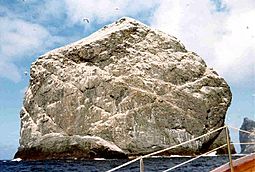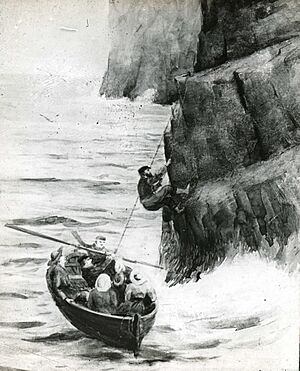Stac Lee facts for kids
| Meaning of name | "ly": shelter |
|---|---|
 Stac Lee, St Kilda |
|
| OS grid reference | NA142049 |
| Coordinates | 57°51′57″N 8°30′35″W / 57.8659°N 8.5097°W |
| Physical geography | |
| Island group | St Kilda |
| Area | 2.3 ha (6 acres) |
| Highest elevation | 172 m (564 ft) |
| Administration | |
| Sovereign state | United Kingdom |
| Country | Scotland |
| Council area | Outer Hebrides |
| Demographics | |
| Population | 0 |
Stac Lee is a tall, thin rock island called a sea stack. It stands proudly off the west coast of Scotland, as part of the St Kilda group of islands. This amazing rock is home to a huge number of northern gannets. In fact, it's part of the world's largest colony of these birds!
People have known about Stac Lee for a long time. In 1698, a writer named Martin Martin called it "Stac-Ly." Other old writings also refer to it as "Stac Lii."
Contents
Where is Stac Lee?
Stac Lee is located in the North Atlantic. It's part of the St Kilda islands, which are themselves part of the Outer Hebrides. Stac Lee is in the northeast of the St Kilda group. It's about 7 kilometres (4 mi) northeast of Hirta, which is the main island in St Kilda. It's also about 550 metres (600 yd) west of Boreray island.
Stac Lee is managed by the local government of the Na h-Eileanan Siar.
How Tall is Stac Lee?
Stac Lee is a very steep sea stack. It stands 172 metres (564 ft) high above the sea. Some measurements say it's 165 metres (541 ft) or even 220 metres (720 ft) from the seabed. Because it rises more than 150 metres (490 ft) from the land around it, it's known as a Marilyn. This is a special term for hills and mountains in Britain that meet certain height rules.
Nearby, another sea stack called Stac an Armin is even taller at 196 metres (643 ft). This makes Stac Lee and Stac an Armin the highest sea stacks in Britain!
What Does Stac Lee Look Like?
If you look at Stac Lee from the south, it seems like a huge cliff, as wide as it is tall. But from the west, it looks like a very thin needle. Its top is angled at 45 degrees. The most amazing view is from the southeast. From there, Stac Lee looks like a giant hook!
Climbing Stac Lee
In the past, people from St Kilda used to visit Stac Lee. They were called fowlers because they collected birds and their eggs. There was a small shelter, called a bothy, on Stac Lee. It was big enough for two people and stayed dry inside. The St Kildans had a very brave way to land there. They would throw a rope with a loop (a lasso) onto an iron peg. Then, they would jump onto the rock when the waves lifted their boat high enough.
In 1899, a climber named Norman Heathcote climbed Stac Lee with his sister Evelyn. He wrote about their adventure in his book St Kilda. He said climbing the stack itself was "comparatively easy." However, getting onto the stack from the boat was "a most appalling undertaking." It meant jumping ashore and climbing a slippery cliff covered in seaweed.
More recently, people have still climbed Stac Lee. On May 21, 1990, three wardens from the National Trust for Scotland reached the top. On October 13, 2014, six climbers made it to the summit. There were even more climbs in October 2015.
Wildlife on Stac Lee
Stac Lee is a very important place for birds. The St Kilda islands have the world's largest colony of northern gannets. There are about 60,000 pairs of these birds that nest on Boreray, Stac an Armin, and Stac Lee.
In 2004, around 14,000 gannet nests were counted on Stac Lee alone. This number has stayed about the same for many years. It shows how important this rocky island is for these amazing seabirds.
Images for kids
-
Stac Lee (right) and Boreray
-
Stac an Àrmainn with Boreray to the left and Stac Lee beyond at right





